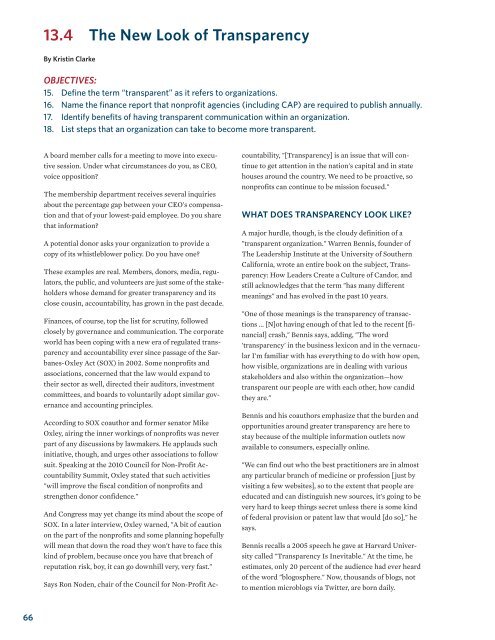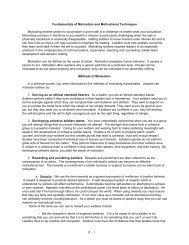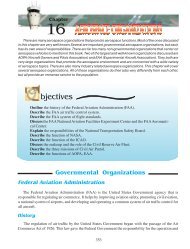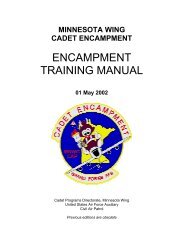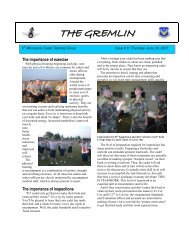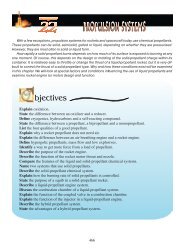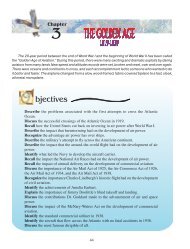13.4 The New Look of TransparencyBy Kristin ClarkeOBJECTIVES:15. Define the term “transparent” as it refers to organizations.16. Name the finance report that nonprofit agencies (including CAP) are required to publish annually.17. Identify benefits of having transparent communication within an organization.18. List steps that an organization can take to become more transparent.A board member calls for a meeting to move into executivesession. Under what circumstances do you, as CEO,voice opposition?The membership department receives several inquiriesabout the percentage gap between your CEO's compensationand that of your lowest-paid employee. Do you sharethat information?A potential donor asks your organization to provide acopy of its whistleblower policy. Do you have one?These examples are real. Members, donors, media, regulators,the public, and volunteers are just some of the stakeholderswhose demand for greater transparency and itsclose cousin, accountability, has grown in the past decade.Finances, of course, top the list for scrutiny, followedclosely by governance and communication. The corporateworld has been coping with a new era of regulated transparencyand accountability ever since passage of the Sarbanes-OxleyAct (SOX) in 2002. Some nonprofits andassociations, concerned that the law would expand totheir sector as well, directed their auditors, investmentcommittees, and boards to voluntarily adopt similar governanceand accounting principles.According to SOX coauthor and former senator MikeOxley, airing the inner workings of nonprofits was neverpart of any discussions by lawmakers. He applauds suchinitiative, though, and urges other associations to followsuit. Speaking at the 2010 Council for Non-Profit AccountabilitySummit, Oxley stated that such activities"will improve the fiscal condition of nonprofits andstrengthen donor confidence."And Congress may yet change its mind about the scope ofSOX. In a later interview, Oxley warned, "A bit of cautionon the part of the nonprofits and some planning hopefullywill mean that down the road they won't have to face thiskind of problem, because once you have that breach ofreputation risk, boy, it can go downhill very, very fast."Says Ron Noden, chair of the Council for Non-Profit Accountability,"[Transparency] is an issue that will continueto get attention in the nation's capital and in statehouses around the country. We need to be proactive, sononprofits can continue to be mission focused."WHAT DOES TRANSPARENCY LOOK LIKE?A major hurdle, though, is the cloudy definition of a"transparent organization." Warren Bennis, founder ofThe Leadership Institute at the University of SouthernCalifornia, wrote an entire book on the subject, Transparency:How Leaders Create a Culture of Candor, andstill acknowledges that the term "has many differentmeanings" and has evolved in the past 10 years."One of those meanings is the transparency of transactions... [N]ot having enough of that led to the recent [financial]crash," Bennis says, adding, "The word'transparency' in the business lexicon and in the vernacularI'm familiar with has everything to do with how open,how visible, organizations are in dealing with variousstakeholders and also within the organization—howtransparent our people are with each other, how candidthey are."Bennis and his coauthors emphasize that the burden andopportunities around greater transparency are here tostay because of the multiple information outlets nowavailable to consumers, especially online."We can find out who the best practitioners are in almostany particular branch of medicine or profession [just byvisiting a few websites], so to the extent that people areeducated and can distinguish new sources, it's going to bevery hard to keep things secret unless there is some kindof federal provision or patent law that would [do so]," hesays.Bennis recalls a 2005 speech he gave at Harvard Universitycalled "Transparency Is Inevitable." At the time, heestimates, only 20 percent of the audience had ever heardof the word "blogosphere." Now, thousands of blogs, notto mention microblogs via Twitter, are born daily.66
"Almost every company is going to be under the gunabout the problems of not being transparent enough,"Bennis warns. He adds, "Look at what happened withToyota by trying to keep [safety issues] quiet, or Merck[whose antiarthritis medication Vioxx was pulled oversafety concerns]—billions of dollars of penalties andlosses of customer support."Because of the high stakes, Bennis urges leaders to workharder to better understand the issue and ask tough questions."They need to know about the whole revolution insocial networking and networking media because of whatis going on there," he says. "That's the key thing. It behoovesorganizations to be as transparent as [possible]without giving away trade secrets."What if they aren't comfortable lifting the cloak? What ifthey don't even see the cloak? "Just look at Enron," Bennissays. "Look at any recent story on whistleblowers. Therisks are enormous and are increasing every day given thenumber of sources we have and the changing nature ofhow we get information right now. The … risks of not havingsome kind of transparency policy are very—well, Idon't think it's worth it."THE COMMUNICATION CONUNDRUMOne of the highest-profile moves toward greater opennessin the association and nonprofit world has been therecently revised IRS Form 990. Calling the updated form"a major step in transparency," charity tracker GuideStarcautioned association leaders in June 2009: "The impactthat the increased transparency will have on nonprofit organizationshas been severely underestimated. It is notsufficient for nonprofit staff and board members simplyto be made aware of these changes. They must also bealert to the changes' strategic implications and have toolsto manage them successfully."That requires good governance, agree GuideStar and others,including public clarity about how board nominationsoccur, are vetted, and are executed; how the board andCEO make decisions; how money is allocated; and howthe mission is progressing.Association finance committees appear to be drawingspecial scrutiny. Who are these people? How were theychosen? How do they make decisions about associationinvestments? One association professional recalls servingon a board that refused to even second her motion to discuss,much less act on, moving investments from companieswith major Clean Water Act violations—even thoughthe organization's mission includes clean water advocacy.Those companies were providing good returns, the boardresponded. Would most members have agreed to set asidemission in favor of profit?Some additional concerns of transparency proponents areweak communication access, content, and delivery, aswell as perceptions around stakeholder inclusiveness. Associationsare now experimenting with new ways to meetmember transparency expectations, whether by adoptingvirtual tools for collaborative note taking and all-accesspost-meeting discussions, tweeting live from events, oruploading recorded meetings to free or paid-accessarchives.Jeffrey Solomon, executive director of Andrea andCharles Bronfman Philanthropies Inc. and author of thebook The Art of Giving, even suggests live streaming yourboard meetings on the internet."Why not?" he asks.Maybe because of the sensitivity of some issues up for debateor worries about directors posturing for cameras?When several nonprofit CEOs heard that suggestion, reactionsranged from snorts to sighs to grimaces. "Thatcould be ugly, but I do wonder if it would help keepeveryone more focused on the job at hand," says one longtimeleader, who asked to remain anonymous out of concernfor how his comments might be perceived by hisboard.Less ticklish are engagement tactics such as addingreader ratings to online articles a la Amazon or reorganizingweb content for easier access.But public evaluations of association speakers, educationsessions, or even attendees' overall conference experiences?That could cause some squirms. What about websiteusage stats such as those provided by the "Green"Hotels Association, which wanted members to see thegrowth in visitorship to its site? Would an organizationtake those stats down if the numbers start dropping?And considering how little time members claim theyhave, when does it all become too much information anyway?There are costs involved in sharing, complain leaders.Staff time, for instance, or the expense of buildingnew web systems or sites.But there the benefits of transparency can also add up. Inhis book, Straight A Leadership: Alignment, Action, Accountability,healthcare leader Quint Studer discusses thevital role of transparency in creating a successful workplaceculture."Leaders have talked about transparency for a long time,but it's never been more important than it is now," saysStuder. "Remember, we share information with employ-67
- Page 1 and 2:
VOLUME FOUR STRATEGIC PERSPECTIVESL
- Page 3 and 4:
VOLUME FOUR STRATEGIC PERSPECTIVESL
- Page 5 and 6:
VOLUME FOUR STRATEGIC PERSPECTIVESL
- Page 7:
VOLUME FOUR STRATEGIC PERSPECTIVESL
- Page 10 and 11:
12CHAPTER 12INTRODUCTION TO STRATEG
- Page 12 and 13:
12.1 Strategic Leadership: Defining
- Page 14 and 15:
mandates or resolutions that would
- Page 16 and 17:
and ambiguity, aspiring strategic l
- Page 18 and 19: 12.2 National Security StrategyThe
- Page 20 and 21: within our borders has always been
- Page 22 and 23: front common challenges like violen
- Page 24 and 25: and our strategy, not sector earmar
- Page 26 and 27: thinking about organizations. She m
- Page 28 and 29: A systemic approach to failure is m
- Page 30 and 31: The late W. T. Grant Company is a r
- Page 32 and 33: the resources - setting the directi
- Page 34 and 35: focal point for describing and inte
- Page 36 and 37: Consequently, we do not restrict th
- Page 38 and 39: paragraphs, Web pages, then edit an
- Page 40 and 41: Web, can be viewed as a CS attempt
- Page 42 and 43: How to evaluate users and contribut
- Page 44 and 45: 13CHAPTER 13LEADING PUBLIC &VOLUNTE
- Page 46 and 47: 13.1 Leadership for Volunteers:The
- Page 48 and 49: 13.2 Take Root: Volunteer Managemen
- Page 50 and 51: QualificationsClearly list educatio
- Page 52 and 53: and effectively track their volunte
- Page 54 and 55: • Understand rules for recognitio
- Page 56 and 57: • Send a birthday card.• Submit
- Page 58 and 59: and tested more than six decades af
- Page 60 and 61: specific interests of the donors, v
- Page 62 and 63: tain) tax-exempt status from the In
- Page 64 and 65: Smucker, 1999).The Internal Revenue
- Page 66 and 67: culture is necessary to ensure the
- Page 70 and 71: ees for a couple of reasons: One, i
- Page 72 and 73: 13.5 Public and Private Management:
- Page 74 and 75: TABLE 1:FUNCTIONS OF GENERAL MANAGE
- Page 76 and 77: 3. Career System. The model corpora
- Page 78 and 79: islative charter - the Clean Air Ac
- Page 80 and 81: In controlling performance, Chapin
- Page 82 and 83: 14CHAPTER 14AIRPOWER ASSTRATEGIC LA
- Page 84 and 85: 14.1 Strategic Air Power: Fulfillme
- Page 86 and 87: carry it out. Their daylight raids
- Page 88 and 89: you did not rely on strategic bombi
- Page 90 and 91: 14.2 Warden and the Air Corps Tacti
- Page 92 and 93: ecomes one of applying sufficient i
- Page 94 and 95: tification, and a Jominian claim to
- Page 96 and 97: courage the rapid and widespread ex
- Page 98 and 99: it to influence physical players in
- Page 100 and 101: 14.4 Basic Air Force DoctrineAF Doc
- Page 102 and 103: earthquake-stricken Haiti. The worl
- Page 104 and 105: perspective. Airmen do not divide u
- Page 106 and 107: Command and ControlCommand and cont
- Page 108 and 109: 14.5 Should the US Maintain the Nuc
- Page 110 and 111: form of human government.” 20 Dem
- Page 112 and 113: obtainable goal. See the Global Zer
- Page 114 and 115: 15CHAPTER 15ORGANIZATIONAL CULTURE
- Page 116 and 117: 15.1 Organizational CultureBy Doria
- Page 118 and 119:
Review. This action strives to unco
- Page 120 and 121:
gram will serve and then having the
- Page 122 and 123:
ticipating the changes being made b
- Page 124 and 125:
Many years of working with change p
- Page 126 and 127:
At the least, the areas of concern
- Page 128 and 129:
15.4 Developing an Innovative Cultu
- Page 130 and 131:
CONCLUDING THOUGHTSIn an ever-chang
- Page 132 and 133:
global issues. Businesses that poss
- Page 134 and 135:
— Sees the big picture—the shif
- Page 136 and 137:
16CHAPTER 16STRATEGIC COMMUNICATION
- Page 138 and 139:
16.1 Principles of Strategic Commun
- Page 140 and 141:
16.2 The Art of NegotiationBy Brend
- Page 142 and 143:
16.3 Negotiating Effectively Across
- Page 144 and 145:
hidden areas can act as cultural ho
- Page 146 and 147:
and four conflict styles. Hammer be
- Page 148 and 149:
maintaining the relationship. As th
- Page 150 and 151:
25 Mitchell R. Hammer, “Chapter 1
- Page 152 and 153:
tural, socioeconomic, and psycholog
- Page 154 and 155:
for the win-win," during which time
- Page 156 and 157:
interests and, at worst, as a gun s
- Page 158 and 159:
Public diplomacy is surely about mu
- Page 160 and 161:
But public diplomats do not have th
- Page 162 and 163:
Photo courtesy of the familyThe LEA
- Page 164:
THE CADET OATHI pledge that I will


